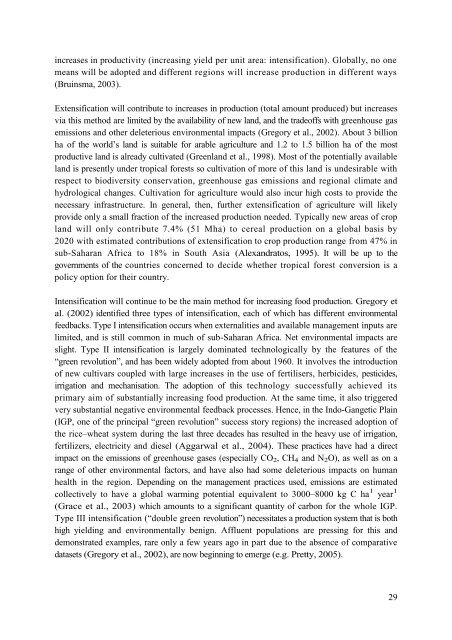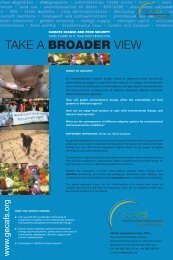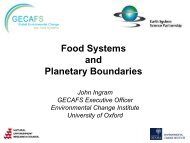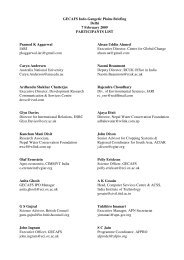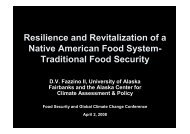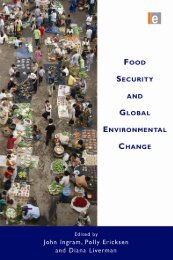From Food Production to Food Security - Global Environmental ...
From Food Production to Food Security - Global Environmental ...
From Food Production to Food Security - Global Environmental ...
- No tags were found...
You also want an ePaper? Increase the reach of your titles
YUMPU automatically turns print PDFs into web optimized ePapers that Google loves.
increases in productivity (increasing yield per unit area: intensification). <strong>Global</strong>ly, no onemeans will be adopted and different regions will increase production in different ways(Bruinsma, 2003).Extensification will contribute <strong>to</strong> increases in production (<strong>to</strong>tal amount produced) but increasesvia this method are limited by the availability of new land, and the tradeoffs with greenhouse gasemissions and other deleterious environmental impacts (Gregory et al., 2002). About 3 billionha of the world’s land is suitable for arable agriculture and 1.2 <strong>to</strong> 1.5 billion ha of the mostproductive land is already cultivated (Greenland et al., 1998). Most of the potentially availableland is presently under tropical forests so cultivation of more of this land is undesirable withrespect <strong>to</strong> biodiversity conservation, greenhouse gas emissions and regional climate andhydrological changes. Cultivation for agriculture would also incur high costs <strong>to</strong> provide thenecessary infrastructure. In general, then, further extensification of agriculture will likelyprovide only a small fraction of the increased production needed. Typically new areas of cropland will only contribute 7.4% (51 Mha) <strong>to</strong> cereal production on a global basis by2020 with estimated contributions of extensification <strong>to</strong> crop production range from 47% insub-Saharan Africa <strong>to</strong> 18% in South Asia (Alexandra<strong>to</strong>s, 1995). It will be up <strong>to</strong> thegovernments of the countries concerned <strong>to</strong> decide whether tropical forest conversion is apolicy option for their country.Intensification will continue <strong>to</strong> be the main method for increasing food production. Gregory etal. (2002) identified three types of intensification, each of which has different environmentalfeedbacks. Type I intensification occurs when externalities and available management inputs arelimited, and is still common in much of sub-Saharan Africa. Net environmental impacts areslight. Type II intensification is largely dominated technologically by the features of the“green revolution”, and has been widely adopted from about 1960. It involves the introductionof new cultivars coupled with large increases in the use of fertilisers, herbicides, pesticides,irrigation and mechanisation. The adoption of this technology successfully achieved itsprimary aim of substantially increasing food production. At the same time, it also triggeredvery substantial negative environmental feedback processes. Hence, in the Indo-Gangetic Plain(IGP, one of the principal “green revolution” success s<strong>to</strong>ry regions) the increased adoption ofthe rice–wheat system during the last three decades has resulted in the heavy use of irrigation,fertilizers, electricity and diesel (Aggarwal et al., 2004). These practices have had a directimpact on the emissions of greenhouse gases (especially CO 2 , CH 4 and N 2 O), as well as on arange of other environmental fac<strong>to</strong>rs, and have also had some deleterious impacts on humanhealth in the region. Depending on the management practices used, emissions are estimatedcollectively <strong>to</strong> have a global warming potential equivalent <strong>to</strong> 3000–8000 kg C ha 1 year 1(Grace et al., 2003) which amounts <strong>to</strong> a significant quantity of carbon for the whole IGP.Type III intensification (“double green revolution”) necessitates a production system that is bothhigh yielding and environmentally benign. Affluent populations are pressing for this anddemonstrated examples, rare only a few years ago in part due <strong>to</strong> the absence of comparativedatasets (Gregory et al., 2002), are now beginning <strong>to</strong> emerge (e.g. Pretty, 2005).29


